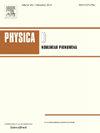Anti-aligning interaction induces gyratory flocking of simple self-propelled particles: The impact of translational noise
IF 2.9
3区 数学
Q1 MATHEMATICS, APPLIED
引用次数: 0
Abstract
This report considers a set of simple active particles (non-self-rotating particles) interacting due to a purely anti-aligning force. Recently, it has been shown that such anti-aligning interaction may induce a finite wavelength instability. The instability occurs with an oscillatory frequency. Consequently, the system displays pattern formation. The formed patterns consist of propagative dissipative structures (two counterpropagating traveling waves). Here, we explore the impact of including translational noise in the dynamics. The finite wavelength instability persists; however, the oscillatory frequency only persists if the particle’s self-propulsion speed is larger enough than the translational noise intensity. We focus on this case. Near criticality, where fluctuations predominate, it is possible to distinguish propagative patterns. Moving away from criticality, a new pattern emerges via a secondary transition. Namely, a hexagonal structure formed of rotating clusters. These clusters rotate in unison, giving rise to a global gyratory synchrony. This secondary transition is discontinuous. Finally, we discuss the main ingredients that induce this sort of rotatory synchronization, showing that short-range repulsion might produce a similar effect to translational noise.
反对准相互作用诱导简单自推进粒子的旋转群集:平移噪声的影响
本报告考虑一组简单的活性粒子(非自旋转粒子)由于纯粹的反对准力而相互作用。最近的研究表明,这种反对准相互作用可能导致有限波长不稳定性。不稳定性以振荡频率发生。因此,系统显示模式形成。形成的模式由传播耗散结构(两个反向传播的行波)组成。在这里,我们探讨了在动力学中包含平移噪声的影响。有限波长的不稳定性持续存在;然而,只有当粒子的自推进速度大于平移噪声强度时,振荡频率才会持续存在。我们专注于这个案子。接近临界时,波动占主导地位,有可能区分传播模式。在远离临界状态的过程中,一种新的模式通过二次过渡出现。即由旋转团簇形成的六边形结构。这些星团同步旋转,形成全球同步旋转。这种次要转变是不连续的。最后,我们讨论了引起这种旋转同步的主要成分,表明短程排斥可能产生与平移噪声类似的效果。
本文章由计算机程序翻译,如有差异,请以英文原文为准。
求助全文
约1分钟内获得全文
求助全文
来源期刊

Physica D: Nonlinear Phenomena
物理-物理:数学物理
CiteScore
7.30
自引率
7.50%
发文量
213
审稿时长
65 days
期刊介绍:
Physica D (Nonlinear Phenomena) publishes research and review articles reporting on experimental and theoretical works, techniques and ideas that advance the understanding of nonlinear phenomena. Topics encompass wave motion in physical, chemical and biological systems; physical or biological phenomena governed by nonlinear field equations, including hydrodynamics and turbulence; pattern formation and cooperative phenomena; instability, bifurcations, chaos, and space-time disorder; integrable/Hamiltonian systems; asymptotic analysis and, more generally, mathematical methods for nonlinear systems.
 求助内容:
求助内容: 应助结果提醒方式:
应助结果提醒方式:


